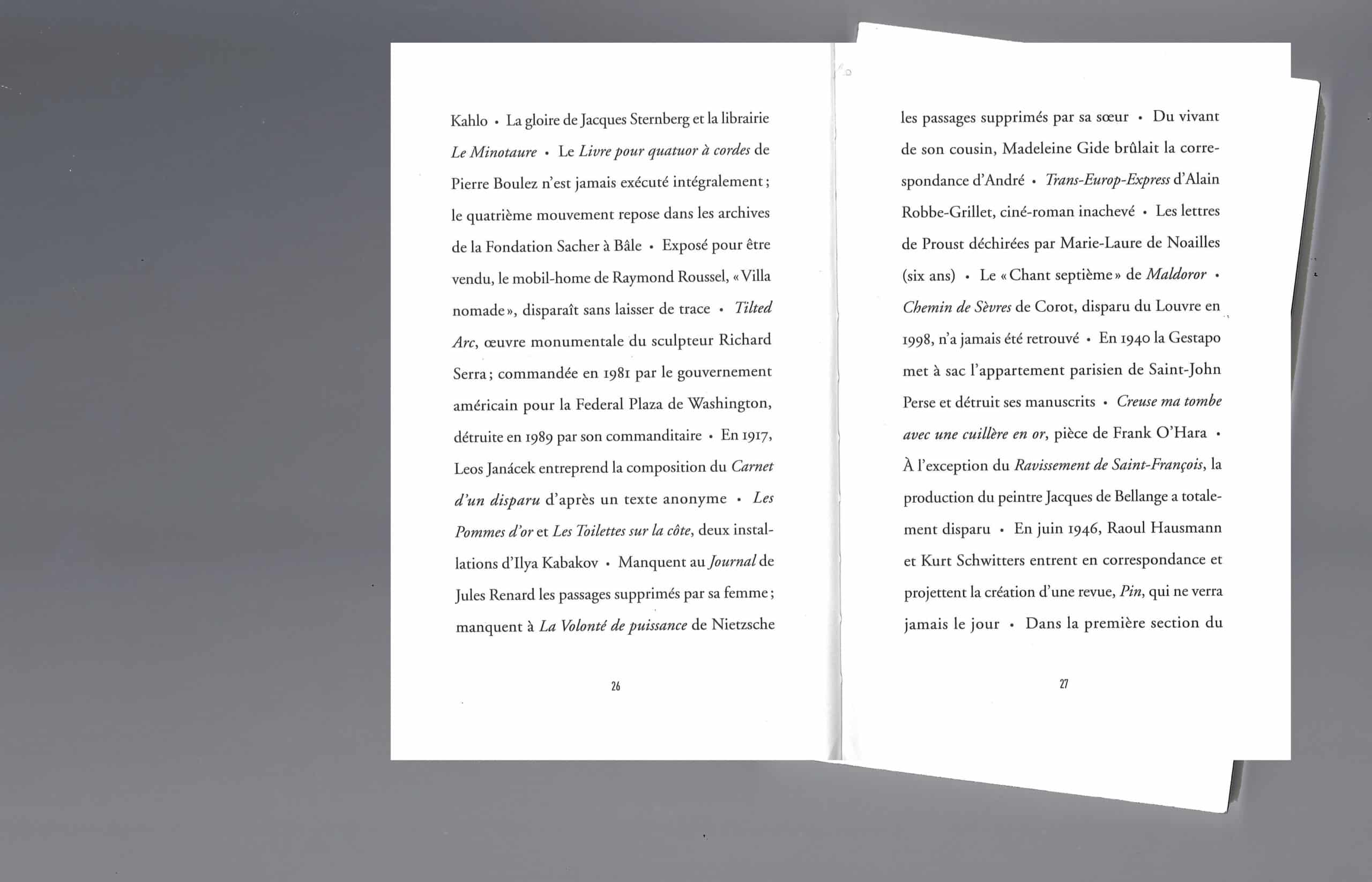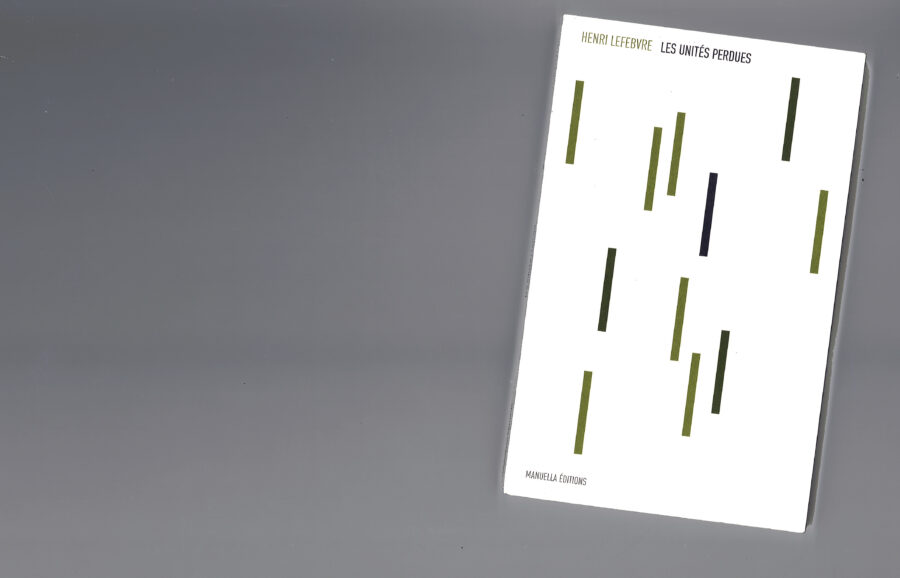Damien Guggenheim: It might be said that your book, Les Unités perdues (The Missing Pieces), is a collection: it includes an inventory of vanished works, in a list, with what can sometimes be pitiless in the way a list behaves. This inventory of course is far from exhaustive. But was there an encounter with a lost work which lies at the origin of this project, as a trigger moment?
Henri Lefebvre: To be precise, several circumstances led to the emergence of this project, which was carried out in three phases. Firstly, you should know that ever since my I was a teenager, I’ve taken a great interest in the biographies of artists. Artists in the broadest sense: painters, composers, writers, filmmakers, etc… on reading these biographies, I was quickly confronted by the recurring theme of the loss of a work. Loss is common, all artists lose works. These are mostly involuntary losses, but they can also be intentional. I realised, especially when it came to involuntary losses, that I found such a loss painful, basically because I then sensed the impossibility of remaking identically a lost manuscript, or a destroyed canvas. I put myself in the shoes of the person who had lost. When the loss is irremediable, then it is unbearable. This painful sensation was the first true “trigger” of the project.
At the time, I didn’t know how to respond to the discomfort these losses made me feel. And then, one day, I noted down a loss that I’d read about. This first loss is described in Elias Canetti’s memoirs, The Play of the Eyes. It concerns the Austrian sculptor Fritz Wotruba who, before leaving Vienna for Switzerland in 1938, decided to bury an untransportable sculpture in a public place in the Austrian capital. On returning to Vienna, in 1945, he tried to recover his sculpture, but couldn’t find it. It had completely disappeared. Writing down this initial anecdote was the second trigger for this project. I then noted down systematically all the losses of works that I found in the biographies of artists that I read.
The third phase: I showed the five pages I’d written to a friend, who’s an already “renowned” poet and who found the text captivating. I was thinking about sending these five pages to the review IF (in Marseille), and she encouraged me to do so. A month later, I got a phone call from Jean-Jacques Viton who said he’d be pleased to publish this text in the next issue of the review, in April 2001. The next day, Liliane Giraudon also phoned me to suggest I turn these “missing pieces” into a series for the review IF, for as long as I wanted to devote myself to them. I accepted and began to work conscientiously on collecting lost works. A week after the initial publication, I got a letter from François Dominique, of Éditions Ulysse fin de siècle. He suggested the idea of a book, which hadn’t even occurred to me; I’d started writing a book without even realising it1.
DG: This work necessarily relies on first and second-hand testimonies. We are thus constantly wavering between police reports and the more or less apocryphal legends that surround artists’ actions. But, as in conceptual art, a legend is enough for the transmission of a work. Isn’t this their strength, being able to survive thanks to their reputation, despite have disappeared?
HL: I love the ambiguity that surrounds my work; I like to think that I can both produce a piece of writing and also a conceptual proposition which can find its place in the world of contemporary art. Your allusion to conceptual art in this respect is thus totally apposite. A work can exist through what is said about it, whether the tale becomes legendary or not. Its existence depends on words and on a text, on what surrounds the physical, material work. A work survives being lost when it has been named. Renaming what has been destroyed so that this naming becomes a work, or remakes a work, in such a way that the work comes back to life without even recovering its material aspect. That’s the real effort behind this book, or its raison d’être. Giving back a role as a subject to a lost work; I hadn’t formulated this when writing the book, which I set about drafting without asking myself any questions. Why write about what we already know? I preferred to discover at the “end” of the book the reason why I’d been determined to write it.
DG: Leaving aside the accidental aspect, there is also a historical dimension. Many of the works you mention are part of the collateral damage of wars, or else have been directly targeted. So, your book is not only a narrative of the backstages of history, but it also confronts the dark side of a history of art based on works that are known and recognised, while trying to assure their survival in posterity. Is Do you thin that a list is the right literary form to relate a history which it is impossible to write otherwise, or a story that doesn’t work as a narrative?

HL: A list, and in particular the litany of Missing Pieces is based on sorrow; it’s no laughing matter, all it can do is act as a reminder of destructions which are, often, due to human, weaponised conflicts. But not only so. Destructions or losses are sometimes also the fruit of bad luck, a slip-up, negligence. They can also be decided by artists, who may then or may not regret what they have done; July 1970, John Baldessari burned the works he’d made between 1953 and 1966, he then never felt an iota of remorse.
A list isn’t just relevant because it tells a “story that doesn’t work as a narrative”, it forms a “narrative” in a different way, without using a traditional, evolving tale. A list states the essential (here, a loss, an absence). A litany is not really a discourse, there’s no development, it underscores. A list is perfectly suited to this exercise of a reminder (about lost works) because it is efficient without being exhaustive – by “efficiency” I mean a brief, striking pronouncement – a list multiplies brief pieces of information – with a sober treatment. The emotion owes much to the sobriety of the treatment. Emotion is born from this logorrhea, this succession of upsets. So, yes, I think it’s the ideal form for a narrative that can only be fragmentary.
A list must be concise, the time period brief. The accumulation of losses incites both a malaise – the feeling of being disarmed in front of so many disasters – and a certain form of pleasure – it (in part) brings vanished works back to life by citing them; they have thus been recalled twiceover: re-named and re-distributed in the flow of art history.
DG: The haunting issue that runs through this open set of a collection is that of a ghost museum, an absence. In other words, we are being confronted by our desire for art. Do we miss these works? What have we lost with them? Can it be said that your work is based on an archaeological approach? Is this not also about the ideal of a masterpiece, with what that implies about intimidation, an impossible quest, which here might be almost ironically under attack? As though giving up on that paradigm might be the conclusion of a long process of grieving?
HL: In this book, and in all my other books, what is under attack – and yes, there is an attack – is what has been concluded or finished. That’s for sure. This is above all conveyed in the form’s incompleteness: “The Missing Pieces” doesn’t contain a single full stop. In this way, the book saves on fullstops by instead leaving blanks, which clearly express an infinity in which everything could be probed or placed. Each “missing piece” is separated from the previous and subsequent ones by a particular sign, a small black circle suspended in the middle of the lines in the text. This is intentional, not to separate or isolate the pieces from each another, but instead to link them together, from all periods, whatever the subject. To express the universality and timelessness of loss and absence, and also to express a perpetuation. Nothing is completed, everything is transformed, everything mixes together into discrete prolongation. A beginning is also an end which has been prolonged.
Then, there is an incompleteness in the contents. Since that time, I’ve no longer want to write anything that comes to an end. I work on my texts as reminders of the incompleteness of everything (this is present in everything). If I understand what you just meant by “masterpiece”, as a finished, completed work of genius, then, yes, that notion is here under constant attack. Because nothing that is alive has really been completed… A supposedly “finished” work seems to me to be a work which is as extinguished as it is useless. The paused, or static, describes states to be banned, but which are infortunately common and sometimes defended. Thus, a “completed” work is a failure because it has been fixed at a moment in its development, because its potential for evolution has been amputated. There are two agonies: the finished work and the lost work. A lost work means a life that has been wiped out (“The Missing Pieces” sets about bringing it back to life, refusing obliteration). The worst thing is surely an obliteration of life, or else parcimony and prudence. We savour life a little, barely. While what we need is not to neglect it. Not neglecting it means being imprudent about the unexpected. Then all will be well, or maybe even better…
Translated by Ian Monk, 2023
1 After the takeover of Éditions Ulysse fin de siècle by Daniel Legrand, Les Unités perdues was published by Éditions Virgile in October 2004. Manuella Editions republished it in 2011. The book was translated in 2014 in the USA (Los Angeles), as “The Missing Pieces”, by Semiotext(e), David L. Sweet (trans); in 2018 in Switzerland (Zürich) and in Germany (Berlin) as “Die fehlenden Teile”, by Diaphanes, Michael Heitz and Sabine Schulz (trans); and in 2019 in Portugal (Lisbon), as “As peças que faltam”,. BCF, Ricardo Nicolau (trans).
